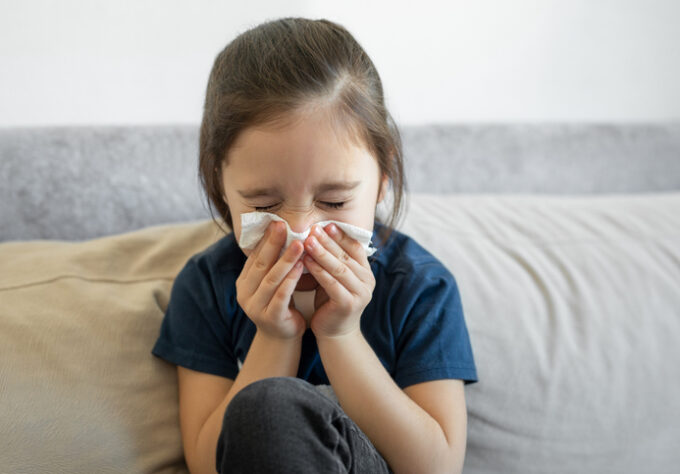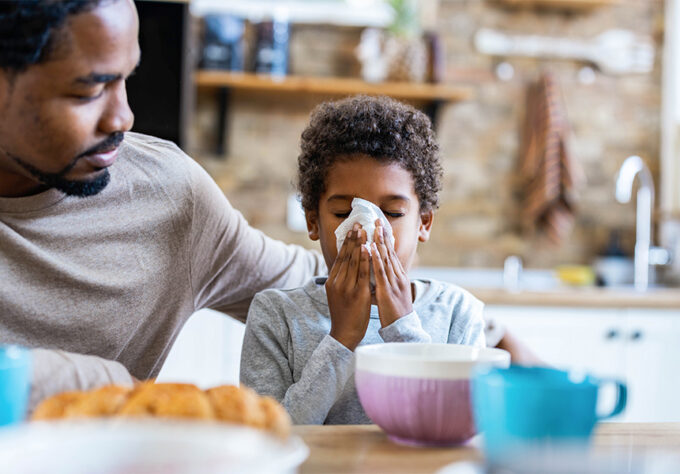Sports, toys and everyday household items have one thing in common: they can cause eye injuries in children. And in some cases, these injuries can become eye emergencies — situations that require immediate medical attention.
The best way to treat eye emergencies is by preventing them in the first place. Be sure your kids use protective eyewear when engaging in sports, play only with age-appropriate toys and don’t have access to household chemicals and utensils.
Still, even after you’ve taken these precautions, eye emergencies can happen. Here’s what to look for and what to do if your child experiences trauma to one or both eyes.
Chemical exposure
Dangerous chemicals are in nearly every area of our home, and if they’re not kept out of a child’s reach, they can cause permanent eye damage.
One particularly dangerous culprit: detergent pods, whose bright colors are appealing to kids.
“Children may try to squeeze the pods,” says Dr. Sharon Lehman, chief of pediatric ophthalmology at Nemours/Alfred I. duPont Hospital for Children. “They think they are a toy or candy because they’re brightly colored, and when they squeeze them, they can squirt into their eyes. This can cause permanent vision loss from a chemical injury or burn to the eye.”
If a child has a chemical burn, whether it’s from a detergent pod or another household chemical, usually the most important thing to do is to flush out the eye. Put the child into a tub or shower, run a comfortable water temperature, and flush the eyes as best you can. Check the bottle on the chemical substance for the phone number of a poison control center, which can further advise you on what to do.
After you flush the child’s eyes, go to the emergency room — not to your pediatrician’s office or urgent care. The emergency room will have the proper equipment to flush the eyes and will be prepared to further treat the emergency.
The most important way to avoid chemical burns to the eye is to keep detergents, bleach and cleaning agents out of children’s reach. Put them up high or, if storing under the sink, invest in child-safety locks.
Blows to the eye
Playing sports is the most common cause of impacts to the eye. And while not all sports injuries can be prevented, many of them can. That’s why it’s important that children use the proper eye guards, such as face shields, goggles or helmets when playing sports — no matter where they are.
“Many injuries happen at home when children aren’t wearing protective eyewear,” Lehman said. “They’ll wear the proper equipment on the field, but when they get home, they let their guard down.”
Toy guns, pellet guns and BB guns are other common causes of blows to the eye. Parents should always supervise children when they are using them. It’s also important to pay attention to the age recommendations on these items.
“When using any type of projectile, a child should have protective eye gear,” she said. “One thing that commonly happens is when everyone thinks they are done using them: one person doesn’t realize and keeps shooting.”
If the child has what is commonly called a black eye — meaning the eyelids are bruised — a cold compress will suffice. But if you’re unsure or your child’s eye looks unusual, you should see a doctor immediately before applying any pressure over the eye.
“If it doesn’t look normal — the white of the eye is red, the eye is cloudy, the eye pain doesn’t go away or there’s a change in vision — you will want to get it checked out right away,” Lehman said. “What we worry about is injury to the eye or the bones around the eye.”
Another sign of an eye emergency is bleeding in the eye. It requires a visit to the emergency room.
“If you see anything that is not normally there, bring the child in right away,” Lehman said.
Dog bites
Even the friendliest dog can lash out — and often at a child’s face and eyes.
“A family pet can and will get too excited and bite the eyelid or cause facial trauma,” Lehman said.
To combat this, parents should keep children and pets separated when an adult is not around, and children should be taught to be mindful of pets when they’re sleeping or eating.
If your child experiences a dog bite to the eye area and the eye doesn’t look normal, or the child is experiencing vision problems or pain, visit an emergency room immediately.
Scratches and cuts
Sand, fingernails and other small objects are also common causes of eye injuries.
“In many cases, if you have a foreign body in the eye, the eye will start tearing, and all of a sudden the child will feel better,” Lehman said.
But sometimes those things can scratch the eye. An eye scratch is usually not serious, and it’s often treated in the pediatrician’s office or in an urgent care center instead of the emergency room. If the cornea is scratched, a doctor will prescribe antibiotic ointment to avoid infection and scarring.
Before you leave to see the doctor for an eye scratch, try flushing the eye. This will sometimes loosen particles that are in the eye. Don’t rub the eye or apply pressure to it.
In rare cases, a child will suffer a cut, which can be serious. Look for abnormalities in the eye — blood is a sure sign — and visit the emergency room immediately.
The most effective way to prevent eye scratches and cuts, though, is by taking the proper precautions. Teach kids not to run with sticks, scissors or other pointy objects, and put bungee cords and sharp objects out of reach. Not all eye emergencies are preventable, but being aware of the dangers is essential, and taking the appropriate action when injuries occur is the first step in treating them.
This article was originally posted on DelawareOnline.



